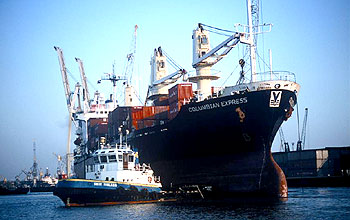BIT - September 2004
Janich & Klass solution at Germanischer Lloyd:
Electronic ship files
Several thousand documents are received daily in the registry of the “Schiff TÜV” Germanischer Lloyd – the entire documentation of the travelling fleet. To cope with the flood of paper, an EDM and archiving system was introduced. The scanning software DpuScan by Janich & Klass ensures the fast capture of the documents.
Germanischer Lloyd (GL), headquartered in Hamburg, was founded in 1867 and is today one of the leading, internationally recognised classification societies. The company carries out safety inspections and certifications of ships and their equipment on the basis of its own technical rules and regulations as well as national and international laws and regulations. Of the total of over 2100 employees, about 1000 work in Hamburg, where the company’s information technology centre is also located.
In the registry, which is also located in Hamburg, the entire documentation of the moving fleet is archived. This includes all survey reports resulting from regular inspections by GL worldwide. The paper archive exploded – over the years, four kilometres of files accumulated.

Introduction of an EDM system with recording
As part of a reorganisation of the documentation system, an EDM system (Engineering Data Management system) was therefore introduced in 2000. At the end of 2002, the Documentum archiving system was also added. GL purchased scanners from Océ and Fujitsu to digitise the documents and drawings. In addition, a suitable recognition system had to be selected in this context. The capture solution was to capture the entire daily incoming mail from the “Moving Fleet” area of approx. 6000 documents within four hours. The documents can be multi-page and have different formats. In addition, they are available in different paper qualities and colours. Furthermore, the future capture system should be able to automatically pre-process the images, i.e. automatically rotate them correctly (autorotation) and correct and filter skew or lateral misalignment. In addition, it should be possible to combine multi-page documents into a multi-page Tiff file. Dr. Ernst Consultec, who was consulted, carried out a benchmark test with three systems, in which DpuScan by Janich & Klass emerged as the clear winner.
Document capture by barcode identification
After the pilot phase, the system was put into productive operation. Before scanning, the documents receive a barcode with a unique document number. The barcode is used to link a consignment and the documents it contains in the EDM system. “We are particularly convinced by the high speed with which DpuScan can process even a high volume of documents, such as we have,” explains Detlev Salzmann, Head of the Registry at GL.
While the capture system was initially purchased primarily for the digitisation of inspection reports, DpuScan’s field of application is now different. Because last year GL integrated the electronic reporting tool TRON into its IT infrastructure. The surveyors have installed this on their notebooks and thus already create the inspection reports digitally. Instead, the DpuScan-equipped scanners at GL currently capture, for example, notes, faxes and letters that – in addition to the inspection reports – belong in a ship’s file. In addition, material and material test certificates are captured, which are generated, among other things, during construction sample tests of new projects. These certificates, which are received from all over the world, are recorded with DpuScan, indexed and stored in a database. The database currently contains about five million material and material test certificates.
Conclusion
“We could not realise our dream of simply throwing away our huge paper archive,” Jensen concludes about the introduction of EDMS at Germanischer Lloyd. “Too many worldwide legal regulations, especially liability law, still require us to keep records in paper form. Thus, we currently maintain two archives – the electronic and the paper archive.” Nevertheless, GL benefits from the digitalisation of incoming mail and ship files: the employees themselves no longer work with the paper-based file but with the electronic one, which leads to considerable time savings. In addition, simultaneous access by several employees to one and the same documents is possible. The engineer in the branch offices has the advantage of being able to access the electronic ship file directly via the Documentum web client without waiting times.

